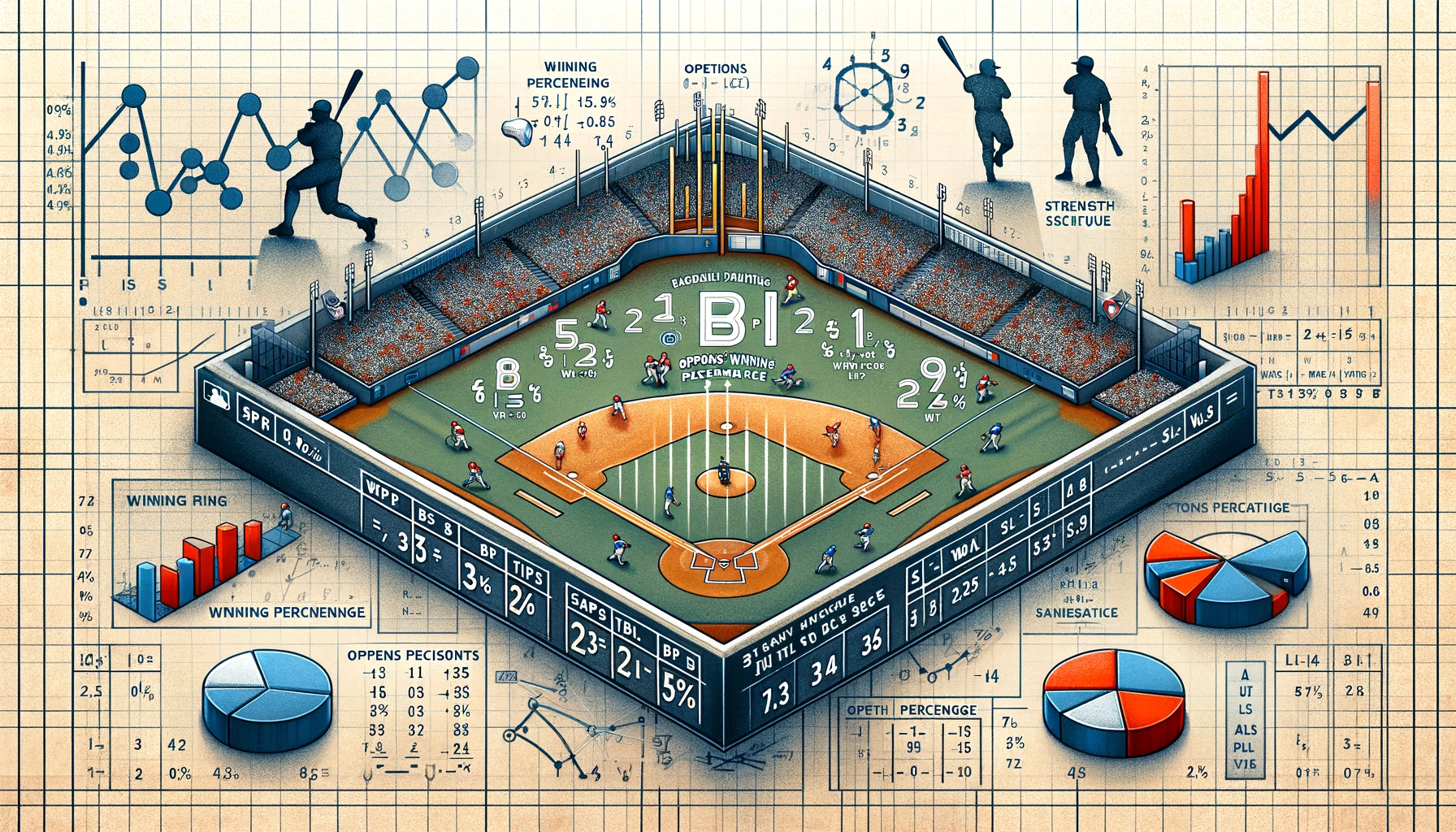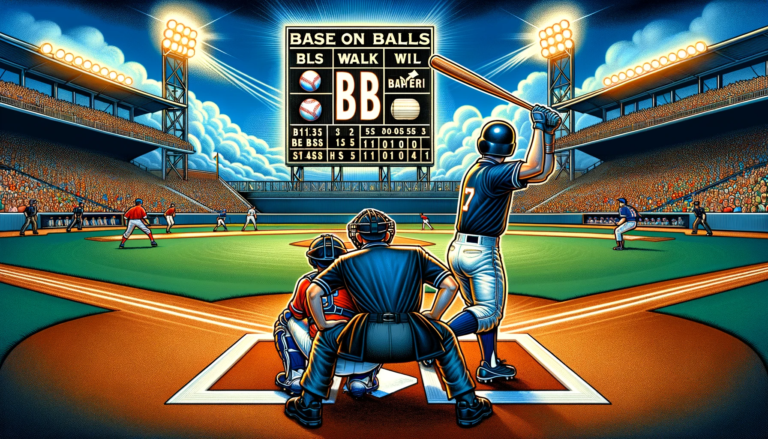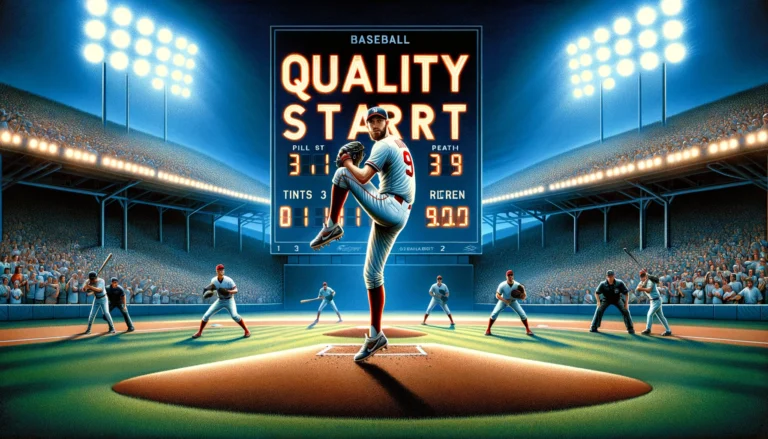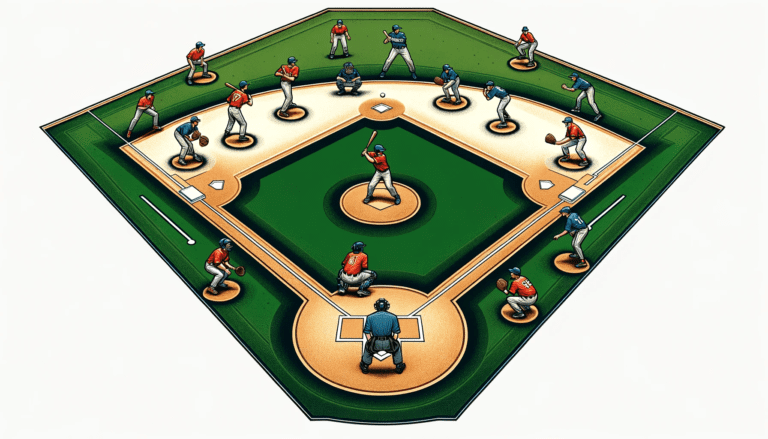What is RPI in Baseball?
RPI stands for Ratings Percentage Index. It is a number used to rank baseball teams based on their wins and losses and the strength of their opponents. A team with a high RPI has played well against other good teams.
Understanding RPI is key for both players and fans alike. So, let’s break it down and discover why it matters in the world of baseball. Ready to dive in?
Let’s explore RPI in baseball together!
Key Takeaways
- RPI is a crucial metric in college baseball, affecting team rankings, strategies, and postseason eligibility.
- The calculation of RPI takes into account a team’s wins and losses, as well as the strength of their schedule.
- Teams, such as Oregon State, can leverage high RPI rankings for competitive advantage, while others like Stanford may struggle due to lower RPI standings.
- The RPI system is subject to debate, with some questioning its accuracy and fairness in reflecting a team’s performance.
- Beyond the numbers, RPI can have a significant personal impact on players’ careers and influence the broader community and culture of college baseball.
Understanding the RPI System in College Baseball

The Basics of RPI and Its Purpose
The Ratings Percentage Index, or RPI, is a quantitative measure used to rank sports teams based upon a team’s wins and losses and its strength of schedule.
It plays a crucial role in determining postseason opportunities for college baseball teams, particularly when it comes to selections and seedings for the NCAA tournament.
The RPI is composed of three factors: the team’s winning percentage, the average winning percentage of the team’s opponents, and the average winning percentage of the opponents’ opponents.
To understand the RPI’s purpose, it’s essential to recognize its impact on the landscape of college baseball. The RPI influences not just team rankings but also shapes the strategies teams employ throughout the season.
For instance, a strong RPI can enhance a team’s resume, making the difference between receiving an at-large bid for the tournament or being left out.
This has led to teams carefully considering their schedules, aiming to improve their RPI by playing against opponents with high winning percentages.
The RPI system is not without its critics, however. Some argue that it places too much emphasis on strength of schedule, potentially penalizing teams in weaker conferences or those with fewer opportunities to play top-ranked opponents.
Despite this, the RPI remains a significant factor in college baseball, affecting decisions from game scheduling to postseason play. You may also read the guide on What Does GIDP Mean in Baseball
Calculating the RPI: A Closer Look
The Ratings Power Index (RPI) in college baseball is a quantitative measure designed to rank teams based on their wins and losses and the strength of their schedule.
The RPI is made up of three components: a team’s winning percentage, the average winning percentage of their opponents, and the average winning percentage of their opponents’ opponents.
To understand the calculation process, consider the following steps:
- Calculate the team’s winning percentage.
- Determine the average winning percentage of the team’s opponents.
- Compute the average winning percentage of the opponents’ opponents.
These figures are then weighted and combined to produce the RPI.
The exact weighting can vary, but traditionally, the team’s winning percentage is weighted at 25%, the opponents’ winning percentage at 50%, and the opponents’ opponents’ winning percentage at 25%.
This formula ensures that teams are rewarded not only for their victories but also for the quality of the competition they face.
Comparing RPI to Other Collegiate Baseball Rankings
While the Ratings Percentage Index (RPI) is a significant tool for evaluating college baseball teams, it’s not the only metric in play.
Other prominent rankings include the D1Baseball Top 25 and the NCAA.com Top 25, which are updated regularly and reflect the opinions of coaches and national polls.
These rankings often provide a snapshot of team performance and are widely followed by fans and analysts alike.
However, the RPI offers a unique perspective by incorporating the strength of the schedule and the results against opponents into its calculation. This can sometimes lead to discrepancies between RPI standings and other polls.
For instance, a team may rank highly in a coaches’ poll due to a strong win-loss record but have a lower RPI if those wins come against weaker teams.
To fully grasp the landscape of college baseball rankings, it’s essential to consider both the subjective nature of polls and the objective analysis provided by RPI.
By comparing these different metrics, one can gain a more comprehensive understanding of a team’s true standing.
Read Also: What Does SU Mean in Baseball
The Impact of RPI on Team Strategies and Performance

RPI’s Influence on Scheduling and Matchups
The Ratings Percentage Index (RPI) plays a critical role in how college baseball teams plan their seasons.
Coaches meticulously analyze RPI rankings to schedule games that will enhance their team’s profile.
A high RPI can be a ticket to better postseason opportunities, making strategic scheduling essential.
Teams often seek to balance their schedule with a mix of strong and weaker opponents. Playing too many low-RPI teams can harm a team’s ranking, while consistently facing top-tier teams can be overly challenging.
The goal is to find the sweet spot that optimizes RPI without overtaxing the players.
- Strategic hits against high-RPI teams can boost a team’s own ranking.
- Disciplined walks through the season’s schedule are necessary to avoid pitfalls.
- Capitalizing on the RPI system requires a deep understanding of its mechanics.
Coaches like Williams College’s Bill Barrale understand the importance of leveraging RPI to their advantage, as seen in their remarkable performances.
The strategic decisions made throughout the season are a testament to the influence RPI has on the collegiate baseball landscape.
How Teams Use RPI for Competitive Advantage
In the competitive world of college baseball, teams leverage the Ratings Percentage Index (RPI) to gain strategic advantages.
Understanding RPI rankings is crucial for coaches and teams as they plan their seasons. The RPI is a tool developed for all team sports, and in baseball, it is used to measure a team’s strength relative to others, based on their wins, losses, and the strength of their schedule.
Teams meticulously analyze RPI data to make informed decisions about their schedules. They aim to improve their RPI by scheduling games against higher-ranked opponents, especially during non-conference play.
This strategy can enhance their resume and increase their chances of a favorable postseason bid.
Here are some ways teams use RPI to their advantage:
- Scheduling: Teams look for opportunities to play against high-RPI opponents to boost their own ranking.
- Strategic Planning: Coaches adjust their game strategies, knowing that a win against a strong team can significantly impact their RPI.
- Recruitment: A high RPI can attract better recruits who are looking to play for a competitive team with a strong chance of postseason play.
Case Studies: Oregon State’s Success and Stanford’s Struggles
The RPI system has had a significant impact on collegiate baseball, and this is particularly evident when examining the contrasting fortunes of Oregon State and Stanford.
Oregon State’s impressive performance is highlighted by their unblemished 13-0 record against teams outside the top 100, a testament to their strategic scheduling and on-field prowess.
In contrast, Stanford’s struggles are underscored by their 3-10 record against top 100 teams, reflecting the challenges they face in a competitive landscape.
- Oregon State’s success is not just about winning games; it’s about dominating the metrics that matter. Their 4.60 RA9 and 1.433 WHIP outpace Stanford’s 6.37 and 1.655, showcasing a superior pitching performance that contributes to their high RPI ranking.
- The case of Stanford serves as a cautionary tale. The loss of key players like their ace pitcher and best batter has led to a significant drop in performance, as evidenced by their low RPI ranking and recent defeats, such as being run-ruled by Arizona.
These case studies demonstrate the real-world implications of RPI rankings on team strategies and outcomes.
While Oregon State continues to thrive, Stanford’s experience highlights the importance of maintaining a strong roster and strategic scheduling to stay competitive in the RPI-driven landscape of college baseball.
Read Also: What Does BB Mean in Baseball
RPI’s Role in Postseason Play and Championships

Determining Postseason Eligibility and Seeding
The RPI, or Rating Percentage Index, plays a pivotal role in shaping the postseason landscape in college baseball.
It is a key factor in determining which teams are eligible for the NCAA tournament and how they are seeded.
The process involves several steps:
- First, the RPI ranks teams based on their wins, losses, and strength of schedule.
- Then, the NCAA selection committee reviews these rankings alongside other factors, such as conference tournament outcomes and notable wins.
- Finally, the committee assigns seeds and brackets teams, aiming to create a balanced and fair tournament field.
This system ensures that teams are rewarded for their performance throughout the season, including the quality of their opponents.
As the postseason approaches, teams often strategize to boost their RPI by scheduling strong non-conference opponents, knowing that a higher RPI can lead to a more favorable tournament position.
Historical Analysis of RPI’s Predictive Success
The RPI, or Rating Percentage Index, has been a cornerstone in evaluating college baseball teams for postseason play.
Historically, the RPI has been a strong indicator of which teams are likely to succeed in the postseason.
The SEC’s strength as the #1 RPI conference has often translated into a significant presence during the playoffs.
For instance, the RPI’s predictive success is evident in the number of host sites a conference secures, with the SEC leaning towards having multiple host sites.
When analyzing the historical data, it’s clear that teams with higher RPI rankings tend to perform better in the postseason.
This correlation between RPI standings and postseason success has been a topic of interest for analysts and fans alike.
The RPI takes into account not only a team’s wins and losses but also the strength of their schedule, which can provide insights into their potential performance against top-tier teams.
However, there have been instances where the RPI did not fully predict the outcome of postseason play. Upsets and unexpected performances often add an element of unpredictability to the championships.
Despite this, the RPI remains a valuable tool for forecasting which teams may have a competitive edge when the stakes are highest.
Potential Cinderella Stories Influenced by RPI
The Rating Percentage Index (RPI) has been a pivotal factor in shaping the narrative of underdog triumphs in college baseball.
Teams that outperform their RPI ranking often become the Cinderella stories of the season, captivating fans and shaking up the postseason landscape.
These unexpected successes can be attributed to a combination of factors:
- A rigorous schedule that bolsters their RPI despite losses
- Key victories against highly-ranked opponents
- Consistent performance that goes unnoticed until critical moments
Such teams leverage their RPI underdog status to fuel their drive for victory. The impact of quality wins against top teams is particularly noteworthy, as these victories can significantly enhance a team’s seeding in the NCAA Tournament selection process.
This dynamic creates an environment where every match-up is crucial, and no victory is too small to count toward a potential postseason upset.
See Also: What is a Crooked Number in Baseball
Debates and Discussions Around the RPI Metric

Critiques and Defenses of the RPI System
The Ratings Percentage Index (RPI) has been a cornerstone in college baseball for ranking teams, but it has not been without its detractors.
Critics argue that the RPI can be overly simplistic, failing to account for the nuances of the game and the strength of the schedule.
They point out that teams can manipulate their RPI by scheduling games against opponents with high RPIs, regardless of the actual competitive balance.
Defenders of the RPI, however, emphasize its objective nature and its long-standing role in providing a consistent metric for comparison.
Supporters also highlight the RPI’s adaptability, as it has undergone revisions to better reflect the quality of wins and losses.
The debate continues with points such as:
- The RPI’s ability to influence postseason eligibility and seeding.
- It impacts how teams schedule their opponents.
- The potential for the RPI to evolve with the sport, incorporating more advanced statistics over time.
Despite the ongoing debate, the RPI remains a significant factor in college baseball, shaping strategies and postseason prospects.
Expert Opinions and Analysis on RPI’s Validity
The Ratings Percentage Index (RPI) remains a topic of intense scrutiny within the collegiate baseball community. Experts often debate its efficacy in accurately reflecting team performance.
While some argue that RPI is a robust metric that accounts for strength of schedule and wins against quality opponents, others point to its limitations, particularly its potential to undervalue certain teams based on geographic and conference biases.
Key points raised by analysts include:
- The importance of RPI in postseason selection and seeding
- The potential for RPI to influence team strategies, such as scheduling
- The debate over whether RPI should be supplemented or replaced by more advanced metrics
Recent discussions have highlighted cases like WVU baseball’s rise in national polls following a series of wins, suggesting that RPI can sometimes lag behind other indicators of a team’s momentum and quality.
As the landscape of college baseball continues to evolve, the conversation around RPI’s validity is sure to remain a dynamic and critical part of the sport’s analysis.
The Future of RPI in Collegiate Baseball
As the landscape of college baseball continues to evolve, so too does the conversation around the Rating Percentage Index (RPI).
The future of RPI may hinge on its ability to adapt to the changing dynamics of the sport.
With the emergence of teams that defy traditional expectations, the RPI system faces scrutiny on its relevance and accuracy in reflecting team performance.
Several factors will likely influence the trajectory of RPI in the coming years:
- The integration of advanced analytics and metrics beyond win-loss records.
- Adjustments to account for the strength of non-conference schedules.
- The potential development of new systems that could supplement or replace RPI.
Experts and analysts continue to debate the merits of RPI, with some advocating for its refinement and others calling for a new era of ranking methodologies.
As collegiate baseball programs adapt to the competitive landscape, the RPI’s role in shaping postseason play and seeding decisions remains a critical point of discussion.
The ongoing analysis of RPI’s predictive success and its impact on team strategies will undoubtedly play a part in determining its longevity and evolution.
Read Also: What Does TB Mean in Baseball
Beyond the Numbers: Human Stories Shaped by RPI

Athletes and Teams Defying RPI Expectations
In the realm of college baseball, the RPI (Ratings Percentage Index) often sets the stage for postseason predictions and team evaluations. However, the narrative is not always dictated by the numbers.
Teams and athletes regularly defy the odds, crafting stories of unexpected triumphs that resonate beyond the statistics.
- The Iowa baseball program is headlining the Big Ten Conference with a season that’s generating unprecedented hype, suggesting a potential upset in the making.
- Despite a lower RPI ranking, Stanford’s performance against top 100 teams indicates a resilience that could disrupt expectations in critical matchups.
- Athletes like Charlie Condon, with a trajectory to hit an astonishing 40 home runs, exemplify individual prowess that can shift a team’s course regardless of its RPI standing.
These instances underscore the dynamic nature of college baseball, where RPI is just one of many factors that contribute to the unfolding drama of the season.
The Personal Impact of RPI on Players’ Careers
The Ratings Percentage Index (RPI) in college baseball is more than just a metric for team rankings; it has a profound personal impact on the players’ careers.
For athletes, a high RPI can be a gateway to greater visibility among scouts and professional leagues, potentially shaping their future in the sport.
- Players from teams with strong RPI rankings often receive more attention during the draft process.
- A team’s RPI can influence the level of competition faced, thereby affecting a player’s development and exposure.
- Individual performance against high-quality opponents can elevate a player’s profile, as scouts frequently evaluate talent in the context of the competition.
The journey of a collegiate athlete is not solely defined by their skills but also by the opportunities presented to them. RPI, by quantifying team strength, inadvertently affects these opportunities.
For instance, a snippet from 247 Sports highlights the significance of Quality 1 (Q1) wins in elevating a team’s RPI, which in turn can enhance a player’s chances of being noticed.
It’s a competitive edge that players and their advisors are keenly aware of, as they navigate the path from college fields to professional dreams.
Community and Culture: The Broader Effects of RPI
The Ratings Percentage Index (RPI) extends its influence beyond the baseball diamond, shaping the community and culture surrounding collegiate baseball.
Local pride and university identity often intertwine with a team’s performance and RPI ranking, creating a ripple effect that touches fans, students, and alumni alike.
- The RPI can become a source of community pride, especially for smaller schools that may not frequently be in the national spotlight.
- It can also influence the culture on campus, with higher RPI rankings leading to increased student engagement and alumni support.
- For cities and towns where college baseball is a major draw, the RPI can affect local businesses and economies, particularly during high-stakes games and tournaments.
The broader effects of RPI are a testament to the power of sports metrics not only in shaping the game but also in fostering a sense of belonging and community spirit.
As teams strive for excellence on the field, their successes and challenges are shared by the entire community, creating narratives that transcend the sport itself.
See Also: What Does MRP Mean in Baseball
Conclusion
In conclusion, RPI in baseball is a vital tool for evaluating team performance. It considers wins, losses, and the strength of opponents to determine rankings.
Understanding RPI helps teams strategize and fans appreciate the sport even more. So, whether you’re a player aiming for the top or a fan cheering from the stands, knowing about RPI adds depth to your baseball experience.
Keep following the game, and remember, RPI plays a big role in the thrilling world of baseball.
Frequently Asked Questions
What is RPI in college baseball?
RPI stands for Ratings Percentage Index. It’s a statistical system used to rank college baseball teams based on their wins, losses, and strength of schedule.
How is the RPI calculated?
The RPI is calculated by considering a team’s winning percentage, the average winning percentage of their opponents, and the average winning percentage of their opponents’ opponents, with each factor given a different weight.
Why does RPI matter in college baseball?
RPI is significant because it influences postseason eligibility, seeding, and can affect a team’s strategy, such as their scheduling of opponents to improve their ranking.
How does RPI compare to other collegiate baseball rankings?
Unlike subjective polls, RPI is an objective metric based on game results and strength of schedule. It’s one of several tools, including polls and other statistical rankings, used to evaluate teams.
Can RPI influence a team’s strategy?
Yes, teams often schedule games with higher-ranked opponents or those with strong schedules to improve their RPI, which can help them secure a better position for postseason play.
Are there any criticisms of the RPI system?
Critics argue that the RPI can be biased towards teams with weaker schedules and doesn’t always accurately reflect a team’s performance or potential. As a result, there are ongoing discussions about how to improve or replace it.







